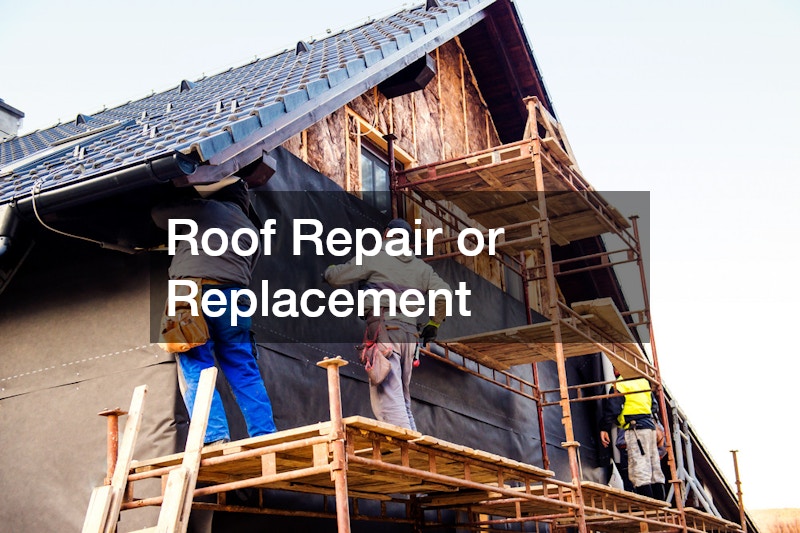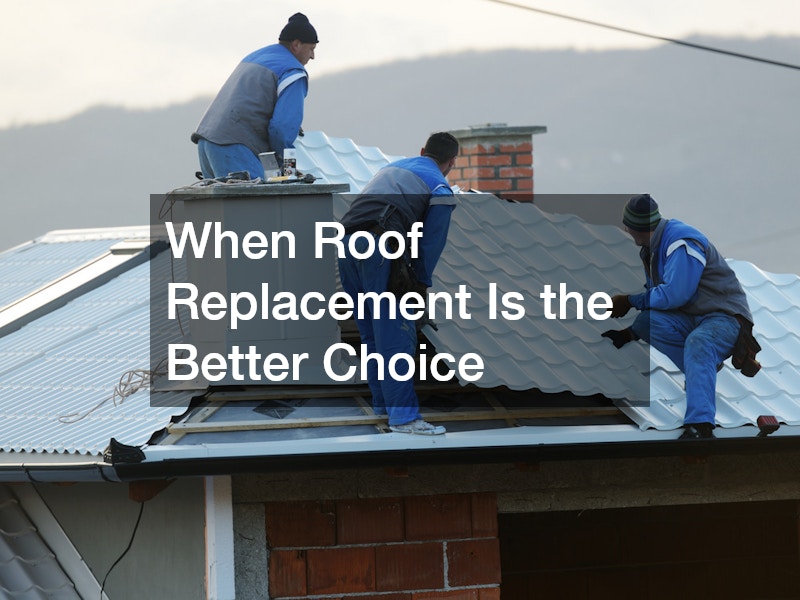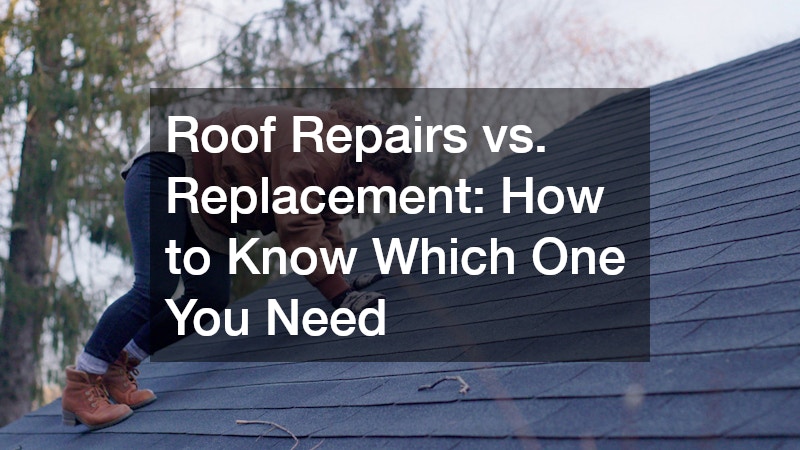
- Minor damage or isolated leaks can often be resolved with repairs.
- Age and roof condition are critical—older roofs often call for replacement.
- Frequent repairs add up—sometimes it’s more cost-effective to replace.
- Structural issues, widespread damage, or recurring problems usually signal replacement.
- Weight, material type, and building codes affect the decision.
- A professional inspection is essential before making a choice.
- Working with a certified roofing company that offers warranties ensures peace of mind and long-term protection.

The difference between roof repair and full replacement isn’t just about cost—it’s about ensuring long-term protection and value. Many homeowners hesitate, unsure of whether repairs will be enough or if a new roof is justified. A premature decision in either direction can lead to wasted money or future headaches.
Roof repairs are typically quicker and less expensive initially. But if underlying issues persist—or the roof is near the end of its lifespan—multiple repairs may cost more over time than investing in a replacement. With some roofs lasting only 20–25 years, while others endure 40 or more, understanding your roof’s age and condition is key to making the right call .
Signs Your Roof May Only Need Repairs
In many cases, roofing issues look worse than they are. With prompt attention, small problems can be repaired quickly and cost-effectively—extending the life of your roof without needing a full replacement. Below is a deeper look into when repairs are enough and how to make smart decisions about maintenance.
1. Localized Damage
Small, isolated sections of damage are one of the clearest signs that a full roof replacement isn’t necessary. This could be:
- A few missing, cracked, or curling shingles
- Isolated areas of flashing damage
- A loose or rusted vent boot
These issues are often caused by wind, falling debris, or minor installation flaws. If caught early, they can be patched or replaced without disturbing the integrity of the rest of the roof.
Tip: Always match new shingles to the existing ones as closely as possible in both material and color to maintain your home’s curb appeal.
- Minor Leaks
Not all leaks indicate roof failure. Small leaks or water stains in one location—especially around roof features like:
- Chimneys
- Skylights
- Plumbing vents
…can often be fixed with sealants or flashing replacements. These trouble spots are more vulnerable because they involve roofing transitions or penetrations, making them common leak points even on otherwise healthy roofs.
Tip: Leaks don’t always appear directly below the source. Water can travel along rafters or insulation before becoming visible inside, so proper inspection is key.
- Storm-Related Damage
After a storm, it’s common to see minor damage like:
- A few missing shingles
- Lifted edges
- Small hail dents
If your roof is relatively new and the damage is limited, a repair is typically faster and more cost-effective. Keep in mind that insurance may cover storm-related repairs if documented quickly.
Tip: Get a professional inspection within a few days after a storm. Hidden damage can worsen over time and may go unnoticed if you wait too long.
- Roof Age Is Below the Lifespan Threshold
Different roofing materials have different lifespans:
- Asphalt shingles: 15–30 years
- Metal roofing: 40–70 years
- Clay or concrete tiles: 50+ years
- Slate: Up to 100 years
If your roof is less than halfway through its expected life and has been maintained well, isolated problems can often be repaired instead of replaced.
Tip: Keep a home maintenance log that tracks the age of your roof, types of repairs done, and dates of inspections. This can help you assess long-term trends.
- No Structural Concerns
If your roof doesn’t show signs of deeper problems—like sagging, soft spots, or water-damaged underlayment—repairs are usually enough. Structural issues often require more extensive work and sometimes complete replacement.
Signs of structural integrity:
- Attic is dry and free of mold
- Rafters and sheathing are intact
- Rooflines are straight with no dips or bends
Tip: A flashlight inspection in the attic after a rainy day can reveal any hidden leaks or mold that might suggest a more serious issue.
Navigating Repair Costs
The cost of a repair varies depending on several factors:
- Type of damage (surface vs. deeper layer)
- Roofing material
- Access difficulty (multi-story homes or steep pitches cost more)
- Labor costs in your area
Here’s a rough range of what you might expect:
| Repair Type | Estimated Cost |
| Small leak patch | $150–$400 |
| Flashing replacement | $300–$600 |
| Shingle replacement (small area) | $200–$1,000 |
| Vent boot repair | $150–$300 |
Cost-efficiency tip: If the cost of repairing the roof exceeds 25%–30% of the cost of a full replacement, it’s worth considering a full roof replacement instead—especially if the roof is aging or the repairs are recurring.
When Roof Replacement Is the Better Choice

While small roof issues can often be fixed with simple repairs, there comes a point when repairs are no longer enough. Choosing to replace your roof at the right time can prevent ongoing problems, reduce long-term costs, and protect your home’s structural integrity. Here are the key situations when a full roof replacement is the smarter move.
- Widespread Damage
If large sections of your roof are showing signs of wear or failure, repairs won’t be enough. Common signs include:
- Shingles that are curling, cracking, or missing in many areas
- Bald spots where granules have worn off
- Discoloration or algae growth across most of the roof
This level of damage indicates the materials are failing due to age, weather, or poor ventilation. Patching a few spots may temporarily hide the issue, but underlying problems will continue to spread.
Tip: Stand back from your home or use a drone to view the entire roof. If the damage isn’t limited to one side or area, it’s time to consider replacement.
- Roof Has Aged Beyond Its Lifespan
All roofing materials have an expiration date. For example:
- Asphalt shingles: 20–25 years
- Wood shakes: 20–30 years
- Metal roofing: 40–70 years
- Tile or slate: 50–100 years
If your roof is nearing or beyond its expected lifespan—even if it looks mostly intact—it may no longer be providing full protection. Older shingles become brittle, lose adhesion, and are more prone to leaks.
Tip: Check your records for the roof installation date. If your asphalt roof is 20 years or older, get a professional inspection to assess remaining life.
- Recurrent Leaks or Frequent Repairs
Constant repairs are not only frustrating—they’re a red flag. If you’ve had to fix several leaks in the past few years, or the same area keeps having problems, there may be hidden issues such as:
- Water-damaged underlayment
- Compromised roof deck
- Poor attic ventilation causing heat/moisture buildup
Over time, these repeated costs add up, and the root issue remains unaddressed. Replacing the roof eliminates recurring headaches and ensures long-term protection.
Tip: If you’ve spent more than 25–30% of the cost of a new roof on repairs in the last few years, it’s more economical to replace it entirely.
- Structural or Decking Damage
Visible structural issues mean your roof is no longer safe. Watch for:
- Sagging or bowing in the roofline
- Soft spots underfoot when walking on the roof
- Water stains or mold in the attic
- Rotted decking or support beams
These signs indicate moisture has penetrated below the surface layers. Repairs won’t fix hidden rot or compromised framing. In these cases, a complete tear-off and rebuild is necessary to restore safety.
Tip: Always inspect the attic when checking for roof problems. Structural issues often reveal themselves indoors before they’re visible outside.
- Multiple Roofing Layers
If your roof has already been re-shingled once (meaning it has two layers), you may not be allowed to install a third. Most local building codes only permit two layers due to:
- Weight concerns (which can strain the roof structure)
- Poor adhesion and ventilation between layers
- Shortened lifespan of the top layer
Tearing off old layers is more work upfront, but it allows for a complete inspection of the decking and ensures the new roof performs at its best.
Tip: A roofing contractor can check how many layers you currently have. If you’re already at two, replacement is likely required.
- Energy Inefficiency or Aesthetic Upgrade Goals
Modern roofing systems are built with better:
- Insulation to reduce heat loss/gain
- Ventilation to regulate attic temperatures
- Reflective surfaces to reduce cooling costs
If your current roof contributes to high energy bills, upgrading could pay off in long-term savings. Additionally, replacing an outdated or damaged roof can dramatically boost your home’s curb appeal and resale value.
Tip: Look for ENERGY STAR®-rated roofing materials if you’re aiming to improve energy efficiency. Some states even offer rebates for energy-efficient roof replacements.
Cost Considerations for Replacement
Replacing a roof is a significant investment, but it offers long-term value. Costs vary based on size, materials, labor, and location. Here’s a rough breakdown:
| Roof Type | Estimated Replacement Cost per Square Foot |
| Asphalt shingles | $3 – $6 |
| Metal roofing | $7 – $14 |
| Tile roofing | $10 – $20 |
| Slate roofing | $15 – $30 |
Other factors like removing old layers, replacing damaged decking, and upgrading underlayment can increase the total.
Pro Tip: Get at least 2–3 quotes from licensed contractors. Be wary of unusually low bids—they may cut corners on materials or workmanship.
Cost Comparison: Repair vs. Replacement
Repair Costs:
- Minor repairs can range from $150 to $1,500, depending on severity and accessibility.
- Labor rates vary; waterproofing small areas is cheaper but doesn’t address underlying issues.
- Repairs may mask aging materials that will require more service soon.
Replacement Costs:
- A full roof replacement typically ranges from $6,700 to $29,800, with an average around $9,900 nationally.
- Costs per square foot vary by materials—from $4 to $11 per square foot for standard asphalt, up to $40 per square foot for specialty materials such as metal or slate.
- Additional expenses may include structural deck repairs, disposal fees, permit costs, and new flashing or gutters.
Long-Term Value:
- Replacement reduces future repair needs and often includes warranties.
- Repairs may only prolong the inevitable if the roof is near its end of life—leading to repeated expenses.
Roof Material Considerations
The type of roofing material affects both lifespan and the ability to repair or replace.
Asphalt Shingles
- Average life: 20–25 years.
- Repairs are easy, but color matching becomes difficult as shingles age.
Metal Roofing
- Can last 40–70 years.
- While durable, patching individual panels—especially cosmetic ones—can be challenging.
Tile or Slate
- Lifespan: 50+ years.
- Individual tiles can be replaced, but structural support and matching tiles may complicate matters.
Flat or Low-Slope Roofs (e.g. membrane roofs)
- Repairs can be straightforward for small leaks, but older systems may develop widespread issues. Replacement is often warranted if there is ponding water or degraded materials.
When to Hire a Pro: Inspection & Decision-Making
Self-assessment can only get you so far. Hiring a qualified inspector ensures a fair evaluation of roof condition.
Inspection benefits:
- Certified inspectors offer unbiased insight without incentive to upsell repairs or replacements.
- Costs may range between $600 and $1,500 depending on roof size, material, and slope.
What to expect from a roof inspection:
- Assessment of roof age, visible damage, and underlying structural integrity.
- Identification of leaks, ventilation issues, insulation needs, and deck condition.
- A written report highlighting which repairs or replacement steps are needed, with prioritized recommendations.
Choosing a contractor:
- Prioritize licensed, insured professionals with clear reputations.
- One-time confusion often comes from contractors recommending full replacements when repair may suffice. Be cautious and seek second opinions when unsure.
Decision-Making Checklist: Repair or Replace?
Here’s a simplified checklist to help you assess your situation:
- Is the damage isolated (e.g. one or two cracked shingles) or widespread?
- How old is your roof relative to its material’s expected lifespan?
- Have you needed multiple repairs recently?
- Are there signs of structural or deck damage (e.g. sagging, rot)?
- Are repair costs more than 25–30% of replacement estimates?
- Do you plan to stay in your home long term—or sell soon?
- Is the roof inefficient or outdated aesthetically?
- Has an unbiased inspection confirmed your concerns?
If many of these apply, it may be time for replacement rather than more repairs.
Final Thoughts: Protecting Your Home with the Right Choice
Deciding between roof repair and replacement isn’t just about money—it’s about safety, peace of mind, and long-term home health. Minor repairs can extend the life of a solidly maintained roof, while full replacement is often the smarter choice for aging, extensively damaged, or structurally compromised roofs.
Don’t wait until leaks flood your ceilings or insulation mold spreads through your attic. Schedule an inspection, evaluate costs, and weigh your long-term goals carefully. When in doubt, choosing a certified roofing company that offers warranties ensures you’re backed by professionals committed to quality and reliability.




